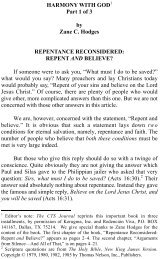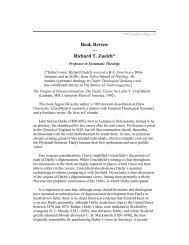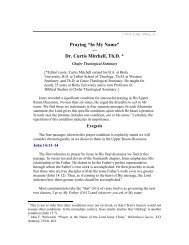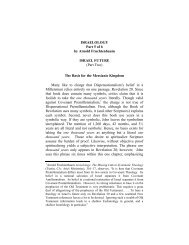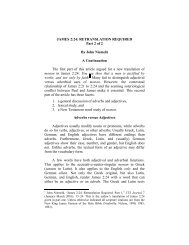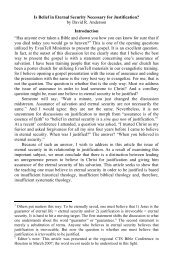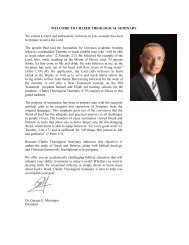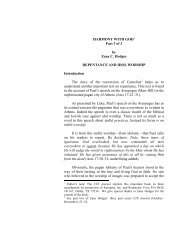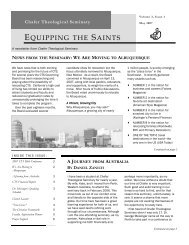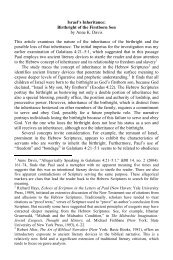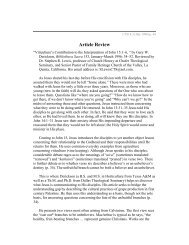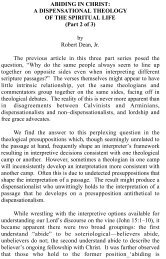Biblical Theology: An Evangelical Approach by David J. MacLeod ...
Biblical Theology: An Evangelical Approach by David J. MacLeod ...
Biblical Theology: An Evangelical Approach by David J. MacLeod ...
You also want an ePaper? Increase the reach of your titles
YUMPU automatically turns print PDFs into web optimized ePapers that Google loves.
<strong>Biblical</strong> <strong>Theology</strong>:<strong>An</strong> <strong>Evangelical</strong> <strong>Approach</strong><strong>by</strong> <strong>David</strong> J. <strong>MacLeod</strong>IntroductionThe aim of this article is to provide a concise introduction to the discipline of<strong>Biblical</strong> <strong>Theology</strong>, in particular the <strong>Biblical</strong> <strong>Theology</strong> of the New Testament.To accomplish this, the article will first provide a few representativedefinitions of the discipline 1 and comment on its major characteristics.Second, it will present the operating presuppositions which guide<strong>Evangelical</strong>s as they approach the task. Third, it will relate <strong>Biblical</strong> <strong>Theology</strong>to the discipline of Systematic <strong>Theology</strong>. Finally, it will discuss themethodology of <strong>Biblical</strong> <strong>Theology</strong>, giving consideration to the organization ofthe materials and the steps in the process.1 The history and contemporary discussion of <strong>Biblical</strong> <strong>Theology</strong> as a distinct branchof the theological curriculum are beyond the scope of the present article. On thehistory of <strong>Biblical</strong> <strong>Theology</strong>, see Rudolf Bultmann, <strong>Theology</strong> of the New Testament(New York: Scribner’s, 1955), 1:237–51; Otto Betz, “<strong>Biblical</strong> <strong>Theology</strong>, History of,”in The Interpreter’s Dictionary of the Bible, 1:432–37; Daniel P. Fuller, “<strong>Biblical</strong><strong>Theology</strong> and the <strong>An</strong>alogy of Faith,” in Unity and Diversity in New Testament<strong>Theology</strong>, ed. Robert A. Guelich (Grand Rapids: Eerdmans, 1978), 195–213; DonaldGuthrie, New Testament <strong>Theology</strong> (Downers Grove: Inter Varsity, 1981), 21–27;George E. Ladd, “<strong>Biblical</strong> <strong>Theology</strong>, History of,” in ISBE 1:498–505. On thecontemporary discussion about <strong>Biblical</strong> <strong>Theology</strong>, see James Barr, “<strong>Biblical</strong><strong>Theology</strong>,” The Interpreter’s Dictionary of the Bible, Supplementary Volume, 104–11; Gerhard Ebeling, “The Meaning of ‘<strong>Biblical</strong> <strong>Theology</strong>,’” The Journal ofTheological Studies, New Series 6 (1955): 210–25; A. M. Hunter, “Modern Trends inNew Testament <strong>Theology</strong>,” in The New Testament in Historical and ContemporaryPerspective, ed. Hugh <strong>An</strong>derson and William Barclay (Oxford: Blackwell, 1965),133–48; I. Howard Marshall, New Testament <strong>Theology</strong> (Downers Grove: InterVarsity, 2004), 17–48; George Eldon Ladd, A <strong>Theology</strong> of the New Testament, rev.Donald A. Hagner (Grand Rapids: Eerdmans, 1993), 7–20; idem., “The Search forPerspective,” Interpretation 25 (January 1971): 41–62; Palmer Robertson, “TheOutlook for <strong>Biblical</strong> <strong>Theology</strong>,” in Toward a <strong>Theology</strong> for the Future, ed. <strong>David</strong> F.Wells and Clark H. Pinnock (Carol Stream: Creation House, 1971), 65–91; KristerStendahl, “<strong>Biblical</strong> <strong>Theology</strong>, Contemporary,” The Interpreter’s Dictionary of theBible, 1:418–32; Pieter A. Verhoef, “Some Thoughts on the Present-Day Situation in<strong>Biblical</strong> <strong>Theology</strong>,” WTJ 33 (November 1970): 1–19; J. G. McConville, “UsingScripture for <strong>Theology</strong>: Unity and Diversity in Old Testament <strong>Theology</strong>,” TheScottish Bulletin of <strong>Evangelical</strong> <strong>Theology</strong> 5 (Spring 1987): 39–54; Charles H. H.Scobie, “The Structure of <strong>Biblical</strong> <strong>Theology</strong>,” TynBul 42 (November 1991): 163–94;Robert Yarbrough, “Adolf Schlatter’s ‘The Significance of Method for TheologicalWork’: Translation and Commentary,” The Southern Baptist Journal of <strong>Theology</strong> 1(Summer 1997): 64–76; R. W. L. Moberly, “How May We Speak of God? A
30CTS Journal 12 (Fall 2006)One further matter should be noted concerning the <strong>Evangelical</strong>’sconviction concerning the nature of revelation. It is presupposed thatrevelation is more than just a history of the religion of Israel and earlyChristianity. 23 It is also more than just “the communication of information.” 24It involves as well God’s revelation of Himself in a series of historicalevents. 25 <strong>Biblical</strong> revelation, in short, is made up of both words and events. 26It includes the self-disclosure of God to men in a series of unique historicalevents of divine deliverance, and it includes the disclosure of the theologicalmeaning of these events. “The events themselves . . . are not self-explanatory;there was always a divinely initiated prophetic or apostolic word ofexplanation.” 27 The preeminent and final revelation of God is, of course, inthe person and work of Jesus Christ (Hebrews 1:1–3).The Place of <strong>Biblical</strong> <strong>Theology</strong>The relationship of <strong>Biblical</strong> <strong>Theology</strong> to other disciplines in the theologicalcurriculum—to Systematic <strong>Theology</strong> in particular—is a subject which hasmethod of writing the history of religion.” Albrecht Ritschl, Justification andReconciliation, 2nd ed., trans. H. R. Mackintosh et al. (Edinburgh: Clark, 1902), 414,quoted in <strong>David</strong> H. Wallace, “<strong>Biblical</strong> <strong>Theology</strong>: Past and Future,” TZ 19 (1963): 94.23 Ladd, A <strong>Theology</strong> of the New Testament, 25.24 Edward J. Young, Thy Word Is Truth (Grand Rapids: Eerdmans, 1957), 41.25 Ladd, A <strong>Theology</strong> of the New Testament, 21. Cf. Carl F. H. Henry, “DivineRevelation and the Bible,” in Inspiration and Interpretation, ed. John F. Walvoord(Grand Rapids: Eerdmans, 1957), 254.26 John Murray, “Systematic <strong>Theology</strong>, Second Article,” WTJ 26 (November 1963):37. In this article Murray supplied a needed corrective to one modern strand of<strong>Biblical</strong> <strong>Theology</strong> which concentrates upon revelation as deed to such a degree thatGod’s verbal revelation to man is prejudiced. It is important to recognize that whileGod does act in history, His special revelation in Scripture is the result of “directverbal communication between God and particular men on particular occasions.”James Barr, “Revelation through History in the Old Testament and in Modern<strong>Theology</strong>,” PSB 56 (May 1963): 11, quoted in John Murray, “Systematic <strong>Theology</strong>,Second Article,” WTJ 26 (November 1963): 38. Barr, “Revelation through History,”7, added that God communicated freely with men “before, during and after these[historical] events.” At the same time, one must not lose sight of the history. Carl F.H. Henry, God, Revelation and Authority, vol. 2, God Who Speaks and Shows, FifteenTheses, Part One (Waco: Word Books, 1976), 311, wrote, “<strong>Biblical</strong> Christianityclaims to be true not only in its many statements about man’s inner life and about thenature of God, but also in a panoply of statements concerning redemptive historicalacts.”27 Ladd, “<strong>Biblical</strong> <strong>Theology</strong>, Nature of,” 506. As Carl Henry noted, the Bible“normatively interprets” these special historical events (“Divine Revelation and theBible,” 255).
36CTS Journal 12 (Fall 2006)certain that God in the unfolding of revelation has regularly employed this principle.From this it follows that the periods should not be determined at random, or accordingto subjective preference, but in strict agreement with the lines of cleavage drawn <strong>by</strong>revelation itself. The Bible is, as it were, conscious of its own organism; it feels, whatwe cannot always say of ourselves, its own anatomy. The principle of successiveBerith-makings (Covenant-makings), as marking the introduction of new periods,pays a large role in this, and should be carefully heeded” (<strong>Biblical</strong> <strong>Theology</strong>: Old andNew Testaments, 16). John Murray, Westminster Seminary’s great systematictheologian, agreed: “<strong>Biblical</strong> theology recognizes that special revelation did not comefrom God in one mass at one particular time. Special revelation came <strong>by</strong> process. Itcame progressively in history throughout ages and generations. . . . Special revelationand the redemptive accomplishments correlative with it have their marked epochs. Itis undeniable that the flood and the institutions related thereto, the Abrahamicrevelations, the Exodus from Egypt, the <strong>David</strong>ic period, the coming of Christ markoutstanding epochs in the history of revelation. . . . The Bible is itself conscious of thedistinct periods into which the history of revelation falls. Although there could bemore detailed subdivision within certain periods, it could not be contested that theBible itself marks off the distinguishing character and momentous significance of thecreation of man, the fall of man, the flood, the call of Abraham, the Exodus, theadvent of Christ. Hence the periods, the creation to the fall, the fall to the flood, theflood to the call of Abraham, the call of Abraham to the Exodus, and the Exodus toChrist are so well defined that this structure must be adhered to in the discipline,biblical theology. . . . The period from the Exodus to Christ would obviously requiresub-division. But there is also good reason for recognizing a unity corresponding tothat of the other periods.” Murray, “Systematic <strong>Theology</strong>, Second Article,” 42, 43 n.22; idem, “Systematic <strong>Theology</strong>,” in Collected Writings of John Murray (Edinburgh:Banner of Truth, 1982), 4:17, 18 n. 2. Two observations are in order. First, althoughsome critics of dispensationalism have objected to the idea that the terms “age” and“period” can be used interchangeably with “dispensation,” it is apparent that Vos andMurray did not. Second, it is striking that Murray’s six periods exactly coincide withthose of Scofield: (1) creation to the fall (“innocence”), (2) the fall to the flood(“conscience”), (3) the flood to the call of Abraham (“human government”), (4) thecall of Abraham to the Exodus (“promise”), (5) the Exodus to Christ (“Law”), (6) theadvent of Christ, or the New Testament era (“grace”). C. I. Scofield, ed., The ScofieldReference Bible (New York: Oxford, 1917), 5, note on Genesis 1:28. Except for thesixth dispensation being renamed “church” instead of “grace,” Scofield’s categoriesremain unchanged in the latest edition of his reference Bible; cf. idem., The ScofieldStudy Bible III (New York: Oxford, 2005), 4, note on Genesis 1:28. Scofield, ofcourse, added a seventh period, viz., the kingdom, or the millennial age. Murray, apostmillennialist, might not have objected to Scofield’s seventh category had it beenframed in postmillennial fashion. However, Murray asserted, “The new revelatoryacts associated with the second advent do not come within the province of biblicaltheology” (“Systematic <strong>Theology</strong>, Second Article,” 43 n. 22; idem., CollectedWritings, 18 n. 2). Dispensational writers, on the other hand, view the millennial ageas the culminating chapter in biblical history and therefore a legitimate part of the
<strong>Biblical</strong> <strong>Theology</strong> 37study of <strong>Biblical</strong> <strong>Theology</strong>. See Alva J. McClain, The Greatness of the Kingdom(Chicago and Winona Lake: Moody and BMH, 1959), 527–31; <strong>David</strong> J. <strong>MacLeod</strong>,“The Fourth ‘Last Thing’: The Millennial Kingdom of Christ,” BSac 157 (January2000): 44–67.60 As Ryrie, <strong>Biblical</strong> <strong>Theology</strong> of the New Testament, 19, noted, <strong>Biblical</strong> <strong>Theology</strong> ofthe Old Testament examines the truth as it was revealed in given periods, while the<strong>Biblical</strong> <strong>Theology</strong> of the New Testament examines the truth as it is revealed in eachindividual New Testament author. The reason for the difference in methodology isthat the Old Testament covers many centuries of time, while the New Testamentcovers less than a century. To illustrate, one of the classic older works grouped itsmaterials in three major blocks (Mosaism, Prophetism, and Wisdom) and severalsmaller blocks (Primeval Age, the Second Age, the time of the Patriarchs, the time ofMoses and Joshua, the wilderness, the settlement of the land, etc.). Cf. GustavFriedrich Oehler, <strong>Theology</strong> of the Old Testament (New York: Funk & Wagnalls,1883; repr., Minneapolis: Klock & Klock, 1978), ix–xix. This setting forth of thetheology of the Old Testament <strong>by</strong> time periods and stratifications of Israelite historyis followed in more recent times <strong>by</strong> Gerhard von Rad, Old Testament <strong>Theology</strong>, 2vols. (New York: Harper & Row, 1965). The approach of von Rad is generally calledthe diachronic (“through time”) method. It should be noted that some Old Testamentscholars have arranged their materials thematically, e.g., Doctrine of God, Doctrine ofMan, etc., in the fashion of systematic theology. See the old classic <strong>by</strong> A. B.<strong>David</strong>son, The <strong>Theology</strong> of the Old Testament (Edinburgh: Clark, 1904), ix–xi. Incontrast to these two methods, a “cross-section” approach has been used <strong>by</strong> WaltherEichrodt, <strong>Theology</strong> of the Old Testament, 2 vols. (Philadelphia: Westminster, 1961).The “cross-section” approach of Eichrodt and others has been called the “structural”method, the “canonical” method, or the “synchronic” (“point of time”) method. In thisapproach one might examine Micah, for example, to consider the theology of the OldTestament at a certain point in time. For a recent and successful attempt to combineboth the diachronic and synchronic methods, see Eugene H. Merrill, EverlastingDominion: A <strong>Theology</strong> of the Old Testament (Nashville: Broadman & Holman, 2006),29–33. For further discussion of the methodology of Old Testament theology see:Gerhard Hasel, Old Testament <strong>Theology</strong>: Basic Issues in the Current Debate (GrandRapids: Eerdmans, 1972), 11–28; Walter C. Kaiser Jr., Toward an Old Testament<strong>Theology</strong> (Grand Rapids: Zondervan, 1978), 1–19; John H. Sailhamer, Introduction toOld Testament <strong>Theology</strong> (Grand Rapids: Zondervan, 1995), 29–193; Paul R. House,Old Testament <strong>Theology</strong> (Downers Grove: IVP Academic, 1998), 11–57 (esp. 53–57).A typical New Testament theology might group its materials as follows: theology ofMatthew, theology of Mark, theology of Luke, theology of John, theology of Paul,theology of Hebrews, etc. Cf. Ladd, A <strong>Theology</strong> of the New Testament, v–vii;Marshall, New Testament <strong>Theology</strong>, 7–8; Ryrie, <strong>Biblical</strong> <strong>Theology</strong> of the NewTestament, 9–10.
38CTS Journal 12 (Fall 2006)The Organization of the MaterialsThe Methodology of <strong>Biblical</strong> <strong>Theology</strong>The structure or organization of <strong>Biblical</strong> <strong>Theology</strong> has been much debated.Two basic methods 61 are open to the student. The first method takes thestandard categories or topics (loci) of Systematic <strong>Theology</strong> and catalogs theteaching of the New Testament author under these. This is the approach used<strong>by</strong> Guthrie, who calls it the “thematic method.” 62 The advantages of thismethod are that it demonstrates the overall unity of the Bible (i.e., it relatesthe block of Scripture under study to the Bible as a whole), emphasizes that<strong>Biblical</strong> <strong>Theology</strong> is normative, and not just descriptive, and “shows at aglance what the writer taught on each subject.” 63 There are seriousdisadvantages to this method, however. It tends to de-emphasize the historicalcontext of the material under consideration. In addition, it does little to revealthe distinct emphases of the individual New Testament authors. Furthermore,it can become little more than an arrangement of proof texts gathered to provea doctrinal point. In short, this method tends to become a subdividing of thediscipline of Systematic <strong>Theology</strong>. 64The second method structures the materials according to the distinctivethinking of the author under investigation. The theology of the NewTestament author (whether it is Matthew, John, or the author of Hebrews,etc.) is expounded “in its own historical setting, and in its own terms,categories, and thought forms.” 65 This is the approach of Ladd, who calls itthe “historical” method. 66Quite often those who adopt the historical method try to structure theirmaterials around the author’s theological “center.” Within the distinct blocks61 For further discussion of the methodology of New Testament theology, see Hasel,New Testament <strong>Theology</strong>: Basic Issues in the Current Debate, 72–139. In addition tothe thematic and historical approaches, Hasel discussed the existentialist approach(Rudolf Bultmann) and the salvation history approach (Oscar Cullmann).62 Guthrie, New Testament <strong>Theology</strong>, 72.63 Ryrie, <strong>Biblical</strong> <strong>Theology</strong> of the New Testament, 20.64 Ryrie, <strong>Biblical</strong> <strong>Theology</strong> of the New Testament, 20; Marshall, New Testament<strong>Theology</strong>, 24. It should be noted that Guthrie, New Testament <strong>Theology</strong>, 72, sought toavoid the worst features of the thematic method <strong>by</strong> grouping the teaching on eachtheme under the various authors. This does grant some historical perspective. Onedoubts, however, that a real sense of the argument and historical situation of thevarious New Testament books is captured in his otherwise excellent work. Guthrie’swork is in fact a halfway house between <strong>Biblical</strong> <strong>Theology</strong> and Systematic <strong>Theology</strong>.It is really a biblical Systematic <strong>Theology</strong> of the New Testament.65 Ladd, A <strong>Theology</strong> of the New Testament, 20.66 Ladd, “<strong>Biblical</strong> <strong>Theology</strong>, Nature of,” 508. Marshall, New Testament <strong>Theology</strong>, 25–27, also adopts this method.
<strong>Biblical</strong> <strong>Theology</strong> 39of New Testament <strong>Biblical</strong> <strong>Theology</strong> (i.e., Matthean, Pauline, Johannine,etc.), it is generally held that each author had one “master idea,” and all othersections of his theology are to a certain degree subordinate to that idea. 67 Tocite but three examples, Marshall found the doctrinal center of Luke in “thesalvation established <strong>by</strong> the work of Jesus,” Käsemann argued thatjustification <strong>by</strong> faith was at the center of Pauline theology, and Ryriesuggested that the high priesthood of Christ is the doctrinal center in theEpistle to the Hebrews. 68There is one possible disadvantage to the historical method: it can lead toa “splintering of theology”—a situation in which one loses sight of the overallunity of the Bible. 69 This danger is avoided, however, when the historicalstudy is carried on from the perspective of faith. When, through theilluminating work of the Holy Spirit, God speaks to the believing scholar fromone segment of revelation, he happily recognizes that it is the same voice thathe hears in other segments. While the descriptive task demands that he focuson the diversity of the New Testament witnesses, he gladly recognizes andaffirms that what he studies is part of a greater whole. The advantage of thehistorical method, as already suggested, is that it preserves the diversity of theNew Testament authors and prevents the variety of emphases in the NewTestament from being obscured. 70The third method, espoused <strong>by</strong> Marshall, is really a variation on thesecond. This method attempts “to trace the development of the ideas that havebeen deposited in the extant writings.” 71 The goal of this method is to see howthe different ideas of the New Testament authors are “related genealogicallyto one another.” 72 The means to accomplishing this goal is to place the NewTestament documents in chronological order and then to trace thedevelopment of ideas from the beginning of the New Testament era to the67 To cite just two examples, P. P. Saydon, “The Master-Idea of the Epistle to theHebrews,” MelT 13 (1961): 19–26; Joseph Plevnik, “The Center of Pauline<strong>Theology</strong>,” CBQ 51 (1989): 461–78.68 I. Howard Marshall, Luke: Historian and Theologian (Grand Rapids: Zondervan,1971), 19, 93–94; Ernst Käsemann, “The ‘Righteousness of God’ in Paul,” in NewTestament Questions of Today (Philadelphia: Fortress Press, 1969), 168–69; Ryrie,<strong>Biblical</strong> <strong>Theology</strong> of the New Testament, 243.69 Guthrie, New Testament <strong>Theology</strong>, 72. This danger was illustrated <strong>by</strong> James R.Branton when he wrote, “There is no Christology of the New Testament; there areChristologies. There is no one divine plan of salvation; there are a variety of plans inthe New Testament. There is no kerygma; there are kerygmas.” Cf. James R. Branton,“Our Present Situation in <strong>Biblical</strong> <strong>Theology</strong>,” Religion in Life 26 (Winter 1956–57):17.70 Ladd, “<strong>Biblical</strong> <strong>Theology</strong>, Nature Of,” 508.71 Marshall, New Testament <strong>Theology</strong>, 25.72 Ibid.
40CTS Journal 12 (Fall 2006)end. 73 This method seems best suited to describing and explaining NewTestament theology as a whole, while the second method is the essentialmethod for studying an individual book or author. Even while studying anindividual book, however, one will want to show how the author’s ideasdeveloped and how they are related to the ideas in earlier and subsequentwritings. 74The Steps of the ProcessExegeting the Book. At this point the question might be asked, How does onego about the task of <strong>Biblical</strong> <strong>Theology</strong>? The present writer would suggest foursteps. First, applying sound hermeneutical principles the student shouldsubject his material to a detailed exegetical analysis. 75 In the process, heshould use the standard tools, not neglecting the commentaries (both new andold) 76 and periodical literature.Tracing the Argument. Having exegeted the book paragraph <strong>by</strong>paragraph, the student should examine and write out the author’s argument ordevelopment of thought. The purpose of this synthetical study is to make clearthe author’s theological emphases and his doctrinal sequence.Establishing the Center. With the theological emphases of the book infront of him, the student should determine the author’s primary theme or73 Ibid., 26.74 Marshall, New Testament <strong>Theology</strong>, 27.75 For a basic introduction to New Testament exegesis, see John D. Grassmick,Principles and Practice of Greek Exegesis (Dallas: Dallas Theological Seminary,1976).76 Several years ago a personal friend of the writer of this article completed hisdoctorate in education at a leading university. His adviser warned him not to citeliterature more than two years old in his dissertation! Such modernity may beappropriate for the social sciences, but it is unacceptable to the evangelicaltheologian. It is with some amusement that the present writer remembers acolleague’s horror at finding a reference to A. B. Bruce in the writer’s dissertation onthe Book of Hebrews. Although the student must take into account (again to useHebrews as an example) the contemporary works of Luke Timothy Johnson, Craig R.Koester, Harold W. Attridge, William L. Lane, Paul Ellingworth, George H. Guthrie,George W. Buchanan, F. F. Bruce, Philip E. Hughes, Matthis Rissi, Otto Michel, C.Spicq and others, he must not neglect the classic works of, among others,Chrysostom, Martin Luther, John Calvin, John Owen, Marcus Dods, Franz Delitzsch,James Moffatt, Alexander Nairne, and—yes—A. B. Bruce. To dismiss the greatexpositors of the past is “both naive and arrogant.” Cf. Brevard S. Childs, The Book ofExodus (Philadelphia: Westminster, 1974), x.
<strong>Biblical</strong> <strong>Theology</strong> 41motif. This theological center, as noted above, will provide the framework forthe arrangement and presentation of the theological materials. 77Arranging the Materials. Using the thought forms and categories of thebiblical author, an outline can now be developed. The materials should bearranged around the doctrinal center and reflect the author’s own emphasesand doctrinal sequence.SummaryIt has been argued in this article that <strong>Biblical</strong> <strong>Theology</strong> is a scientific (i.e.,systematic) discipline, that it pays attention to the historical context, that itemphasizes the progressive nature of revelation, and that it is biblical. It hasbeen affirmed that there are certain operating presuppositions, whichdistinguish the evangelical practice of the discipline. Furthermore, it has beenargued that although <strong>Biblical</strong> <strong>Theology</strong> differs from Systematic <strong>Theology</strong> inprecedence, purpose, perspective and content, the two are reciprocaldisciplines. Also, it has been argued that the historical method is superior tothe thematic method. Finally, a methodological process involving four steps(exegesis, argument, theme, and outline) has been proposed.ConclusionIn conclusion, the writer of this article would like to say something about itstitle, “<strong>Biblical</strong> <strong>Theology</strong>: <strong>An</strong> <strong>Evangelical</strong> <strong>Approach</strong>.” For some readers theterm “evangelical” is such a broad category that it is almost meaningless touse it. John Stott, for example, has recently referred to the “57 varieties ofevangelicalism,” 78 and Clive Calver has spoken of “the twelve tribes ofevangelicalism.” 79 On a more serious note, <strong>David</strong> Wells has spoken of threedifferent trends in evangelicalism that have emerged since World War II:“confessional, transconfessional, and charismatic.” 80 The first of hiscategories he also calls “conservative, or ‘definite.’” 8177 For the present writer’s effort at establishing the center of a New Testament book,see <strong>David</strong> J. <strong>MacLeod</strong>, “The Doctrinal Center of the Book of Hebrews,” BSac 146(July 1989): 291–300.78John Stott, <strong>Evangelical</strong> Truth: A Personal Plea for Unity, Integrity andFaithfulness (Downers Grove: IVP, 1999), 22. Stott attributes his remark to theunnamed editor of The Church of England Newspaper (April, 1998).79 Clive Calver and Rob Warner, Together We Stand (London: Hodder and Stoughton,1996), 128–30.80<strong>David</strong> Wells, “On Being <strong>Evangelical</strong>: Some Theological Differences andSimilarities,” in <strong>Evangelical</strong>ism: Comparative Studies of Popular Protestantism inNorth America, the British Isles and Beyond, 1700–1990, ed. Mark A. Noll, <strong>David</strong> W.Bebbington, and George A. Rawlyk (New York: Oxford University Press, 1994),389–410 (esp. 391–92). (1) “Confessional” or “conservative” describes the movement
42CTS Journal 12 (Fall 2006)The present article has been written from the perspective of confessionalor conservative evangelicalism. In a 1978 monograph J. I. Packer argued thatsuch evangelicalism makes four general claims and holds to six fundamentalconvictions: 82 The four claims are: (1) <strong>Evangelical</strong>ism is practicalChristianity, i.e., it is a matter of total discipleship. (2) <strong>Evangelical</strong>ism is pureChristianity, free from accretions and dilutions. (3) <strong>Evangelical</strong>ism is unitiveChristianity; i.e., it seeks to avoid a sectarian spirit. (4) <strong>Evangelical</strong>ism isrational Christianity, as opposed to the popular preoccupation withexperience. The six convictions are the following: (1) the supremacy of HolyScripture (the Bible is the inspired and inerrant Word of God through whichthe Holy Spirit speaks to men’s hearts); (2) the majesty of Jesus Christ (i.e.,the Lord Jesus is God incarnate); (3) the lordship of the Holy Spirit (4) thenecessity of conversion, (5) the priority of evangelism, and (6) the importanceof fellowship in the local church.In light of these claims and convictions it should be apparent that thepractitioner of <strong>Biblical</strong> <strong>Theology</strong> must be an evangelical. He must be born ofthe Spirit of God, since this is a prerequisite to knowing and making use ofdivine revelation (1 Corinthians 2:6–3:4). He must be convinced that theBible is a supernatural, thoroughly reliable book (2 Timothy 3:16–17). Hemust work for the glory of Christ and in dependence upon the illuminatingpower of the Holy Spirit. He must be a growing, maturing Christian, sincematurity is a prerequisite for understanding the “solid food” of the Wordfrom the 1940s to the late 1970s. This group seeks to define evangelical belief interms of biblical doctrine. (2) “Transconfessional” describes another wing of themovement that arose in the 1970s. This element shifted “from confessional substanceto simple, organized fraternity . . . . The importance of theological belief is beingreplaced <strong>by</strong> the importance of effective strategy, proficient fund-raising, and the boldbuilding of personal bases of power and influence.” (3) “Charismatic” includesPentecostal, and non-Pentecostal renewal movements in Protestantism “that are notprimarily theologies. Both arise centrally from a spiritual intuition about the presenceof the Holy Spirit. . . . Here, biblical confession arises not as a thing in itself but as anadjunct to the experience of the Holy Spirit.”81 Wells, “On Being <strong>Evangelical</strong>,” 394.82 J. I. Packer, The <strong>Evangelical</strong> <strong>An</strong>glican Identity Problem: <strong>An</strong> <strong>An</strong>alysis (Oxford:Latimer House, 1978), 15–23. Packer’s exposition of each point should be read. <strong>An</strong>umber of such lists exist today. For example, D. W. Bebbington lists fourcharacteristics that are special marks of conservative evangelicals: (1) Conversionism,i.e., the need to be converted to faith in Christ for salvation, (2) activism, i.e., the needto be involved in the central task of evangelism, (3) biblicism, i.e., a high regard forHoly Scripture, and (4) crucicentrism, i.e., the centrality of the cross and theredemptive work of Christ. See D. W. Bebbington, Evangelism in Modern Britain(London: Unwin Hyman, 1999), 2–3; cf. Alister McGrath, <strong>Evangelical</strong>ism and theFuture of Christianity (Downers Grove: IVP, 1995), 55–56.
<strong>Biblical</strong> <strong>Theology</strong> 43(Hebrews 5:13–14. Finally, he must labor at his task mindful that his work isfor the building up of the body of Christ (Ephesians 4:11–12).<strong>David</strong> J. <strong>MacLeod</strong> received his Th.M. and Ph.D. at Dallas Theological Seminary. Heis Dean for <strong>Biblical</strong> Studies and faculty member of Emmaus Bible College inDubuque, Iowa, as well as Associate Editor of The Emmaus Journal. Dr. <strong>MacLeod</strong>has contributed articles to Bibliotheca Sacra and The Emmaus Journal. Besides hisacademic career, <strong>David</strong> ministers the Word in his home church where he serves as anelder. His e-mail address is dmacleod@ emmaus.edu.



